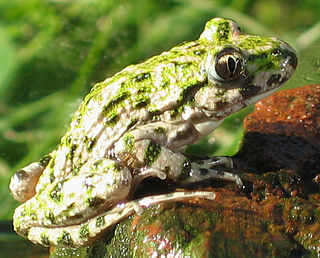
Pelodytidae, also known as the parsley frogs, or rarely, mud divers, is a family of frogs. It contains a single extant genus, Pelodytes, and two genera only known from fossils. The extant species are found in southwestern Europe and the Caucasus.
Colonel Richard Henry Beddome was a British military officer and naturalist in India, who became chief conservator of the Madras Forest Department. In the mid-19th century, he extensively surveyed several remote and then-unexplored hill ranges in Sri Lanka and south India, including those in the Eastern Ghats such as Yelandur, Kollegal, Shevaroy Hills, Yelagiri, Nallamala Hills, Visakhapatnam hills, and the Western Ghats such as Nilgiri hills, Anaimalai hills, Agasthyamalai Hills and Kudremukh. He described many species of plants, amphibians, and reptiles from southern India and Sri Lanka, and several species from this region described by others bear his name.
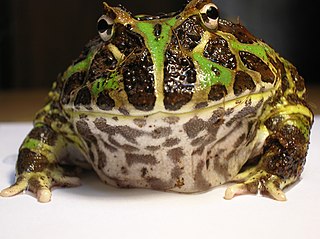
The Ceratophryidae, also known as common horned frogs, are a family of frogs found in South America. It is a relatively small family with three extant genera and 12 species. Despite the common name, not all species in the family have the horn-like projections at the eyes. They have a relatively large head with big mouth, and they are ambush predators able to consume large prey, including lizards, other frogs, and small mammals. They inhabit arid areas and are seasonal breeders, depositing many small eggs in aquatic habitats. Tadpoles are free-living and carnivorous or grazers (Chacophrys).

The Cycloramphidae are a family of frogs endemic to southeastern Brazil. This family has seen large changes in its composition. Genera that have at some point been included in the Cycloramphidae are at present placed in the Alsodidae, Hylodidae, Leptodactylidae, and Rhinodermatidae. Of these, the Alsodidae and/or Hylodidae have also been considered as subfamilies of Cycloramphidae ; the Cycloramphidae, as recognized at present, would be similar to subfamily Cycloramphinae under such system.
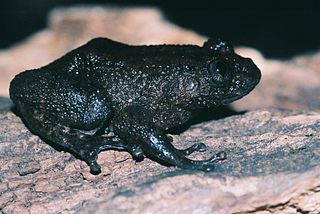
Nyctibatrachus is a genus of frogs endemic to the Western Ghats of southwestern India. Their common name is night frogs. Their scientific name also means "night frog", in reference to their habits and dark color. They are the only extant members of the monotypic subfamily Nyctibatrachinae. Currently, 35 species belong to Nyctibatrachus.
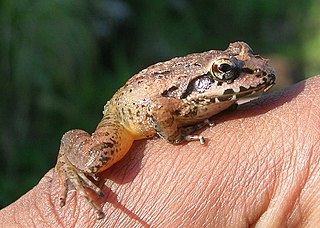
Indirana is a genus of frogs in the family Ranixalidae. These frogs are endemic to the Western Ghats of India. They are sometimes known under the common name Indian frogs, whereas members of their parent family are named "leaping frogs".

The Petropedetidae are a family of frogs containing three genera and 12 species. They are found in sub-Saharan tropical Africa and are sometimes known under common name African torrent frogs.

Lankanectes corrugatus is a species of frog in the family Nyctibatrachidae. It was once monotypic within the genus Lankanectes, until the second species - Lankanectes pera was described in 2018 from Knuckles Mountain Range. It is endemic to Sri Lanka.

Lankanectes is a genus of frogs in the family Nyctibatrachidae that is endemic to Sri Lanka. It is the only member of the Nyctibatrachidae to be found outside India and the only member of the subfamily Lankanectinae.

The Bombay night frog, also known as Abdulali's wrinkled frog, Abdulali's night frog or Humayun's wrinkled frog, is a species of frog in the family Nyctibatrachidae. It is endemic to the Western Ghats of Maharashtra state, India. The species is found near torrential hill streams in tropical moist evergreen and semi-evergreen forests, a habitat that is threatened by habitat loss and pollution. Its name honours Humayun Abdulali, an Indian biologist.

The Kempholey night frog is a species of frog in the family Nyctibatrachidae.

The Dattatreya night frog is a species of frog in the family Nyctibatrachidae first described in the Shola forests around the Dattatreya Peeta in the Chikkamagaluru district of Karnataka. It is still known only from this part of the Western Ghats, India.

Pristimantis is a very large genus of frogs distributed in the southern Caribbean islands and in Central and South America from Honduras to northern Argentina and southern Brazil. With 596 described species, the genus had more species than any other genus of vertebrate animals. Many of these species genus are endemic to the Northwestern Andean montane forests ecoregion in north-western South America.
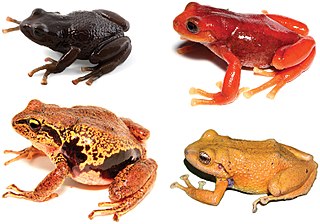
Craugastoridae, commonly known as fleshbelly frogs, is a family of New World direct-developing frogs. As delineated here, following the Amphibian Species of the World, it contains 129 species. They are found from the southern United States southwards to Central and South America.
The Jog night frog or Jog's night frog is one of 12 species of nocturnal frogs in the genus Nyctibatrachus. It is found exclusively in the Western Ghats, India, and both sexes share the responsibility of watching over the eggs.

Hylarana, commonly known as golden-backed frogs, is a genus of true frogs found in tropical Asia. It was formerly considered highly diverse, containing around 84 to 96 valid species, but taxonomic revision resulted in a major change in the contents of the genus, and today it is recognised as containing just four species.

Lankanectes pera is a species of frog in the family Nyctibatrachidae. It is the second species found within the genus Lankanectes. It is endemic to Sri Lanka. Its common name is Corrugated Frogs.

Astrobatrachus is a genus of frogs in the family Nyctibatrachidae that is endemic to the Western Ghats of India. It is the only member of the subfamily Astrobatrachinae and is represented by a single species, Astrobatrachus kurichiyana, commonly known as the starry dwarf frog.

Nyctibatrachus manalari, the Manalar night frog, is a species of frog in the family Nyctibatrachidae. It was discovered in the Western Ghats along with six other species in its genus.
















